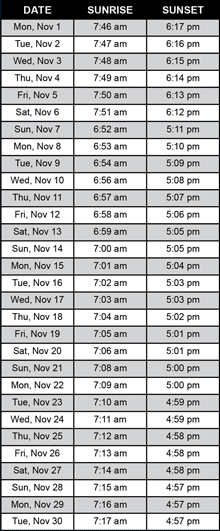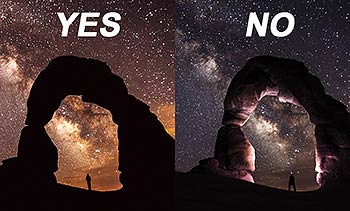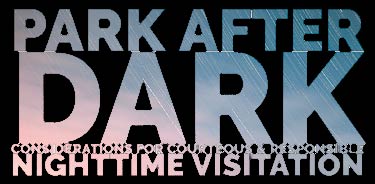DARK SKY HAPPENINGS - November 2021
Moab
UT (at City Hall)
38O34’ N Latitude
109O33’ W Longitude
4048 ft - 1234 m |
Measure the Night Sky
By National Park Service
Sunrise-Sunset
(The time of sunrise and sunset assumes a flat horizon. Actual time may
vary depending upon the landscape.) |
 |
Fall and winter months bring longer nights, and with these earlier evenings, even the youngest astronomers can get stargazing. One of the handiest things you can teach a new astronomer is how to measure the sky – and if you haven’t yet learned yourself, it’s easier than you think!
Astronomers measure the sky using degrees, minutes, and seconds as units. These may sound more like terms for measuring time - and that’s a good catch! – but today we are focused on measuring angular distance. Degrees are largest, and are each made up of 60 minutes, and each minute is made up of 60 seconds. To start, go outside and imagine yourself in the center of a massive sphere, with yourself at the center, extending out to the stars: appropriately enough, this is called the celestial sphere. A circle contains 360 degrees, so if you have a good view of the horizon all around you, you can slowly spin around exactly once to see what 360 degrees looks like, since you are in effect drawing a circle from inside out, with yourself at the center! Now break up that circle into quarters, starting from due North; each quarter measures 90 degrees, equal to the distance between each cardinal direction! It measures 90 degrees between due North and due East, and a full 180 degrees along the horizon between due North and due South. Now, switch from a horizontal circle to a vertical one, extending above and below your head. Look straight above your head: this point is called the zenith, the highest point in the sky. Now look down toward the horizon; it measures 90 degrees from the zenith to the horizon. You now have some basic measurements for your sky.
Keep practicing to build advanced star-hopping skills. Precise measurement of the heavens is known as astrometry.

MOON HAPPENINGS
Nov 4 - New Moon at 3:14 pm
Nov 11 - First Quarter at 5:45 am
Nov 19 - Full Moon at 1:57 am |
Moab Dark Skies mission is to promote the appreciation and conservation of Moab’s valuable and rare dark skies. Moab Dark Skies was established by the Friends of Arches and Canyonlands Parks in conjunction with the National Park Service and Utah State Parks Division of Natural Resources
For more information, check out our Facebook page. |
 |
A Chariot of Fire
by Spencer Stokes Dead Horse Point State Park Ranger
|
 A change of seasons brings new opportunities for astronomers who love to watch the night sky. Constellations move, darkness arrives earlier in the evening, and cold temperatures clear the horizon of haze. One of the winter constellations, Auriga, is of particular interest to star lovers. Auriga is the charioteer in Greek mythology and is full of stunning objects. (image provided by freestarcharts.com) A change of seasons brings new opportunities for astronomers who love to watch the night sky. Constellations move, darkness arrives earlier in the evening, and cold temperatures clear the horizon of haze. One of the winter constellations, Auriga, is of particular interest to star lovers. Auriga is the charioteer in Greek mythology and is full of stunning objects. (image provided by freestarcharts.com)
The charioteer may get its name and story from the hero Erichtonius of Athens. Erichontunis was the son of Hephaestus and was raised by the goddess Athena. He was the inventor of the Quadriga, the four-horse chariot, which he used in battle to successfully become the king of Athens. After his heroic deeds, the Gods placed him in the heavens as a reward. Some of the oldest legends surrounding Auriga indicate that it was a shepherd, which would explain why the constellation is often portrayed as a charioteer with a pair of young goats in hand. Scholars believe that several myths may have been combined to create the constellation of Auriga in western astronomy.
 There are a handful of amazing deep space objects found in Auriga. One of the most fascinating is Messier 37, which is one of the brightest and richest open star clusters. Messier 37 is composed of approximately 500 stars, it appears as a faint point of light with the naked eye but telescopes and binoculars reveal a stunning tapestry of stars. Auriga also contains Capella, an incredibly bright and unique star. Capella is very easy to identify because of its intense luminosity, as it easily outshines every other star in the constellation. What makes Capella truly special is that it’s actually a system of 4 stars. Two binary stars make up the system, one set made of bright yellow stars and the other made of small cool red dwarf stars. In atin Capella translates to the little goat. One of the other intriguing deep space objects found in Auriga is the Flaming Star Nebula, which is a reflection and emission nebula. It reflects light produced by its center star, AE Auriga, and the gases in the nebula also release light. Astrophotographers love the Flaming Star Nebula because of its rich colors. The handful of deep space objects such as M37, Capella, and the Flaming Star Nebula found in Auriga make the constellation very interesting indeed. (image provided by NASA) There are a handful of amazing deep space objects found in Auriga. One of the most fascinating is Messier 37, which is one of the brightest and richest open star clusters. Messier 37 is composed of approximately 500 stars, it appears as a faint point of light with the naked eye but telescopes and binoculars reveal a stunning tapestry of stars. Auriga also contains Capella, an incredibly bright and unique star. Capella is very easy to identify because of its intense luminosity, as it easily outshines every other star in the constellation. What makes Capella truly special is that it’s actually a system of 4 stars. Two binary stars make up the system, one set made of bright yellow stars and the other made of small cool red dwarf stars. In atin Capella translates to the little goat. One of the other intriguing deep space objects found in Auriga is the Flaming Star Nebula, which is a reflection and emission nebula. It reflects light produced by its center star, AE Auriga, and the gases in the nebula also release light. Astrophotographers love the Flaming Star Nebula because of its rich colors. The handful of deep space objects such as M37, Capella, and the Flaming Star Nebula found in Auriga make the constellation very interesting indeed. (image provided by NASA)
Watch the northeast horizon in the early evening to see a pentagon-shaped constellation rise into the night sky. Auriga is easy to spot due to the shimmering stars and recognizable pattern. Bring a pair of binoculars, or a telescope, to see outstanding star clusters and a ghostly nebula. The charioteer is a compelling sight in the dark skies of southeast Utah! |
Stargazing Etiquette
form Colorado Plateay Dark Sky Cooperative
|
Considerations for Courteous & Responsible Nighttime Visitation—an interview with Karen Garthwait, Interpretive Media & Volunteers, Arches & Canyonlands National Parks
 |
| Night photography is a great way to enjoy Arches National Park, but please note that using artificial light sources to light up landscapes, rock formations, or other park features is prohibited. Artificial light sources may be used for personal route-finding or minimum impact camping only. |
Why is using artificial light sources to light up landscapes, rock formations, or other park features prohibited at parks such as Arches National Park?
Spot-lighting for wildlife is nearly always prohibited at parks, through a combination of 36 CFR 2.2(e) and park-specific closures in superintendents’ compendia. It stands to reason that intentionally lighting up park features at night also affects wildlife living nearby. Even if that impact is unintentional, it’s detrimental.
Furthermore, visitors trying to experience and enjoy natural darkness are also negatively impacted by artificial lighting on features. It causes people to lose their dark-adapted vision, which takes time to develop and can be lost in one careless flashlight beam. As dark-sky tourism increases in popularity, more and more parks are explicitly prohibiting activities that negatively impact nighttime visitors’ enjoyment.
Night photography is a great way to enjoy Arches National Park, but please note that using artificial light sources to light up landscapes, rock formations, or other park features is prohibited. Artificial light sources may be used for personal route-finding or minimum impact camping only.
How do I know if lighting is regulated when I visit a National Park or Monument?
Regulations vary a lot from place to place; you can’t assume that an activity allowed at one park is allowed everywhere. It’s a good idea to check each park’s website before visiting even if you’ve been there before; regulations can change. For national park units, you’ll usually find a page called “Park Regulations” within the section called “Plan Your Visit.” These pages help you plan what to pack and what to do (and not do) there. You might also learn something about the place you are about to experience, which can deepen your understanding and enjoyment.
What is light painting and is it also prohibited?
Light-painting is a photography technique involving illuminating a subject while taking a long exposure photograph. The result shows a well-lit subject (around here, typically a rock feature) in the foreground with a star-filled sky behind. The technique can create stunning, even mesmerizing images, which feel like they capture the natural grandeur of the setting until you realize that the lighting effect could only occur unnaturally. This technique is prohibited in Arches and Canyonlands national parks, among other places.
 What general stargazing etiquette behaviors do you most recommend to nighttime park visitors?
What general stargazing etiquette behaviors do you most recommend to nighttime park visitors?
Protecting your and others’ night vision is crucial to maximizing your enjoyment of a dark sky. The human eye can perceive an amazing amount of star light if you let it adapt to the darkness for at least ten to twenty minutes. Avoid using or looking at any bright white or blueish lights. If you must illuminate your surroundings, use a red lamp if you have one; or, carry your light down by your side aimed strictly at the ground. (You can even put a few fingers over the face to narrow the beam to just what you need.) Preserving a park’s natural soundscape further enhances the experience of a nighttime visit. Instead of listening to music, try listening for the sounds of nocturnal critters scurrying about their “day’s work.”
What kind of activities are appropriate in the park after dark?
As diurnal creatures, humans rarely get to observe the nightly dramas of animal behavior, moon shadows crossing the landscape, meteors streaking overhead, and all that comprises “the park after dark.” Some park visitors at nighttime prefer to sit quietly and observe with all their senses: watching, listening, enjoying the touch of nighttime breezes and the scents of night-blooming flowers. Others may choose to hike a trail, paying close attention to trail markers and using a headlamp or flashlight aimed at the ground for route-finding. Hikers might find moonlight is all they need when crossing open areas with mostly level ground, but it’s always a good idea to have extra lights ready for when conditions change.
What is the best way to approach someone who is using light inappropriately in the park?
I find it is always best to assume good intentions. While awareness of the value of naturally dark skies is growing, many people still don’t know about the impacts their lighting causes. If you feel safe approaching someone, you can offer information and polite suggestions for alternate lighting behaviors. Or, you can choose to report the observed activity to a ranger. They might not be able to contact the specific party you saw, but reports like that help make park staff aware of behavioral trends that might need closer monitoring.
|
|